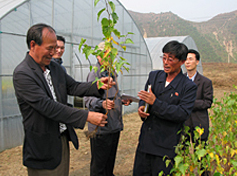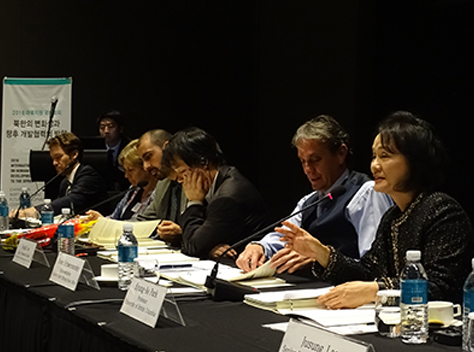Main Activities
■ Humanitarian Aid & Development Cooperation Programs in the DPRK
- General Assistance and Emergency Relief
Humanitarian aid to the DPRK began in the mid-1990s when devastating famine in the North necessitated the need for emergency food assistance. South Koreans, sharing ethnic roots with those in the North, rallied to the cause and a nationwide campaign to support civilians in North Korea was born paving the way for the foundation of KSM in June 1996.
Early efforts to provide emergency relief to North Koreans played a tremendous role in promoting the concept of Inter-Korean peace and reconciliation. Such activities also gradually alleviated antagonistic sentiments towards people in the DPRK that had hitherto been widespread among South Koreans. This became a key impetus in the transition of the nature of the Inter-Korean relationship from confrontation to cooperation.
Along with food provision, KSM has expanded its assistance program to clothing, agriculture, livestock, school meal supplies, educational equipment, and other essential goods, thanks to broad participation across society. Although KSM’s food aid and emergency relief reduced throughout the 2000s as the South Korean government carried out large-scale cooperative development projects with regards to food, fertilizer, agro-livestock, and health care, it continued to participate in disaster relief and provide supplies crucial to improving North Koreans’ quality of life. - Agricultural and Livestock Breeding Programs
KSM’s humanitarian programs began in order to address food shortages that were afflicting North Korean civilians. However, it became increasingly clear that food aid alone could not fully resolve the issue. Therefore around the turn of the millennium KSM sought to enhance agricultural productivity by restoring agro-livestock production infrastructure, thereby shifting the nature of its assistance to development projects.
KSM’s agricultural programs in North Korea include providing agricultural equipment and materials (such as vinyl and fertilizers), repairing machinery, constructing agricultural assembly production factories, and knowledge transfer of modern agricultural technologies. In 2006, KSM programs evolved through a comprehensive modernization project of a certain farming village located in the vicinity of Pyongyang. KSM also made progress in programs related to livestock breeding; starting from sending goats to the North in 1999, KSM has expanded to poultry farming and swine husbandry. - Medical Aid Program
North Korea’s most pressing needs in the late 1990s pertained to food shortages. At this time food aid was prioritized ahead of medicinal support. Moreover, there are difficulties in implementing health care projects without a thorough understanding of the sector. Nevertheless, North Korea’s healthcare situation was as dire as its nutrition condition. Due to a lack of medicine and medical equipment the health care system was on the brink of collapse and many civilians were exposed to various diseases.
KSM implemented a number of projects which focused on pharmaceutical production plant construction, hospital refurbishment, and exchange programs connecting medical experts between South and North. In Pyongyang, KSM built an intravenous (IV) fluids plant, tablet production plant, and a pharmaceuticals quality management plant. The refurbishment project was carried out in Choson Red Cross General Hospital. KSM has participated in the Pyongyang Medical Science Conference four times since its inception in 1999 and held forums related to oriental medicine, rehabilitation, and dentistry. - Reforestation Program
Prior to the division of the peninsula, the northern area had richer forest resources than southern Korea. However, economic hardship and energy shortages in the 1990s accelerated widespread logging and land reclamation, rapidly deteriorating forests. Moreover, deforestation deprived forests’ ability to regulate flooding and drought, leaving farmland increasingly vulnerable to natural disasters and citizens to food shortages.
KSM has sought to tackle this issue since 2006 through the initiation of tree nursery projects in North Korea. Tree nurseries where seedlings are grown are imperative to re-forestation in North Korea. Through such pilot project, KSM developed a model for modernizing tree nurseries with the goal of expanding this throughout other parts of the country. - IT Education Program
As the focus of humanitarian efforts in North Korea gravitated from emergency relief to development projects KSM looked for ways to empower North Koreans with education and training. Only when North Korea moves beyond being a recipient and becomes self-sufficient do development projects become sustainable. To this end, KSM established a ‘Human Resource Education Center’ in May 2006 to provide ICT education. Up until 2009, when the program halted due to rising tensions between South and North Korea, KSM administered the education program twice a year in Dandong, China, with around 200 trainees coming from universities such as the Kim Il-Sung university, educational institutions and professional IT organizations such as the Korea Computer Centre.
■ Policy Research
KSM’s policy research spans widely, including analyzing North Korea policies, discussing hospitable conditions for engaging North Korea, inter-Korean peace and integration, etc. These activities helped elicit numerous institutional changes such as the diversification of the means of communication with North Korea on inter-Korean projects, permission for freedom of assistance fundraising for North Korea, and the introduction of the matching fund. This all began in the late 1990s when the problems engulfing North Korea and South Korea’s deep-rooted antagonism towards the North co-existed. KSM’s research scope broadened throughout the 2000s in accordance with the changing nature of humanitarian assistance – comprehensive discussion on the inter-Korean relationship and peace process, development cooperation, geopolitical analysis of Northeast Asia, and more.
The Center for Peace & Sharing was established within KSM in December 2003 to systemize past works and ensure that they contribute to improving future projects with North Korea. The Center for Peace & Sharing has held forums and debates on various subjects while continuing research.
■ Peace Education
Over the past 20 years, KSM has witnessed a major transition taking place in the Korean Peninsula from a place of animosity and conflict to mutual understanding and reconciliation. However, 70 years of separation and division have manifested in the deeply rooted, so called South-South conflict within South Korea, so that in the past 20 years, the scars of this conflict have become apparent on the individuals’ sensitivity about, and conception of, peace. Without a reawakening and reexamination of this sensitivity, reconciliation and integration between South and North will be limited in what it can reap. KSM has since 2013 strived to respond to this issue through peace education programs with children and students, the future change makers of the peninsula.
KSM’s peace education shuns one way lecturing in favor of open discussion and participation involving both facilitator and student as well as among students. The KSM program Football 4 Peace Korea promotes peace education through sports, paving the way for a new model of engaging peace with facilitators and students.
■ International Cooperation
From its earliest days, KSM has been pivotal in organizing international networks and arenas of consultation with regards to humanitarian assistance to and cooperation with North Korea. KSM also plays a leading role in international cooperation through the hosting of international conferences; starting with the International Consultation on Emergency Food Situation (Musgrove II) meeting in 1997, through the International NGO Conference on Humanitarian Assistance to DPRK in 2005, and then every year since 2009 KSM has co-hosted the International Conference on Humanitarian and Development Assistance to the DPRK alongside Gyeonggi Province and Ebert Stiftung Korea Office.
■ Korean Diaspora Support Program
Those involved in the sharing aspect of KSM are not confined to those Koreans living on the peninsula. One of the core values that brought KSM into existence was the notion that the ‘sharing’ with Koreans was for those facing difficulty wherever they may live around the world. This sharing can become the basis for reconciliation and future reunification. In other words, re-unification is not merely a geographical idea on the Korean peninsula but rather should extend beyond territorial integration and involve Korean communities around the world in a collective effort at reconciliation. Whether this diaspora developed because of economic migration, Japanese colonialism, war, or division, reconstructing relationships through cooperation is at the heart of KSM’s understanding of unification. With this principle in mind KSM has operated numerous programs supporting Korean diaspora communities overseas.
Facts & Figures
|
Year |
No. of Visits |
No.of Visitors |
Pyeongyang |
Nampo |
Sineuju |
Gaesung |
Geumgangsan |
Others |
|
No. of Visits / No. of Visitors |
||||||||
|
1998 |
2 |
4 |
1/2 |
1/2 |
||||
|
1999 |
8 |
29 |
2/13 |
4/10 |
2/6 |
|||
|
2000 |
19 |
79 |
8/48 |
8/20 |
3/11 |
|||
|
2001 |
20 |
106 |
14/85 |
5/17 |
1/4 |
|||
|
2002 |
24 |
212 |
20/203 |
3/7 |
1/2 |
|||
|
2003 |
21 |
363 |
19/356 |
2/7 |
||||
|
2004 |
26 |
168 |
18/136 |
4/15 |
4/17 |
|||
|
2005 |
62 |
972 |
37/811 |
6/13 |
2/18 |
17/130 |
||
|
2006 |
72 |
704 |
60/647 |
2/2 |
8/48 |
2/7 |
||
|
2007 |
65 |
2,962 |
38/471 |
3/3 |
24/2,488 |
|||
|
2008 |
49 |
618 |
13/217 |
2/12 |
4/4 |
22/377 |
1/1 |
7/7 |
|
2009 |
25 |
84 |
9/59 |
4/4 |
2/11 |
10/10 |
||
|
2010 |
40 |
83 |
2/21 |
1/4 |
5/26 |
32/32 |
||
|
2011 |
38 |
63 |
2/6 |
8/31 |
28/28 |
|||
|
2012 |
27 |
30 |
3/6 |
24/24 |
||||
|
2013 |
12 |
12 |
12/12 |
|||||
|
2014 |
11 |
15 |
1/5 |
10/10 |
||||
|
2015 |
15 |
15 |
15/15 |
|||||
|
2016 |
15 |
15 |
15/15 |
|||||
|
2017 |
2 |
2 |
||||||
|
2018 |
25 |
40 |
2/17 |
23/23 |
||||
|
Total |
578 |
6,578 |
235/3,092 |
34/101 |
24/65 |
90/3,125 |
5/15 |
179/180 |
|
Year |
General Assis. |
Medical/Health |
Agriculture Livestock |
Meals for Children |
Total |
|
1996 |
171,500 |
171,500 |
|||
|
1997 |
4,612,180 |
492,000 |
5,104,180 |
||
|
1998 |
330,000 |
420,000 |
750,000 |
||
|
1999 |
2,290,000 |
376,500 |
135,000 |
2,801,500 |
|
|
2000 |
6,382,900 |
202,190 |
1,871,270 |
8,456,360 |
|
|
2001 |
5,344,390 |
556,000 |
2,823,230 |
220,000 |
8,943,620 |
|
2002 |
2,108,750 |
1,090,530 |
3,928,850 |
165,710 |
7,293,840 |
|
2003 |
2,891,390 |
1,952,370 |
1,209,710 |
1,302,180 |
7,355,650 |
|
2004 |
1,007,250 |
4,726,480 |
2,074,080 |
78,125 |
7,885,935 |
|
2005 |
1,640,380 |
1,397,730 |
3,390,790 |
10,476 |
6,439,376 |
|
2006 |
828,920 |
1,499,140 |
5,264,130 |
5,180 |
7,597,370 |
|
2007 |
3,076,948 |
1,090,922 |
3,068,778 |
44,096 |
7,280,744 |
|
2008 |
4,181,110 |
3,875,382 |
2,427,461 |
67,044 |
10,550,997 |
|
2009 |
4,163,576 |
229,980 |
3,150,606 |
114,590 |
7,658,752 |
|
2010 |
666,312 |
114,917 |
528,114 |
212,403 |
1,521,746 |
|
2011 |
47,000 |
1,120,368 |
234,491 |
1,401,859 |
|
|
2012 |
30,453 |
371,177 |
401,630 |
||
|
2013 |
11,236 |
36,872 |
391,916 |
440,024 |
|
|
2014 |
243,004 |
243,004 |
|||
|
2015 |
168,475 |
168,475 |
|||
|
2016 |
399,458 |
332,717 |
732,175 |
||
|
2017 |
206,463 |
190,996 |
397,459 |
||
|
2018 |
22,840 |
640,653 |
663,493 |
||
|
Total |
40,390,216 |
18,269,381 |
30,784,019 |
4,152,580 |
93,596,196 |















